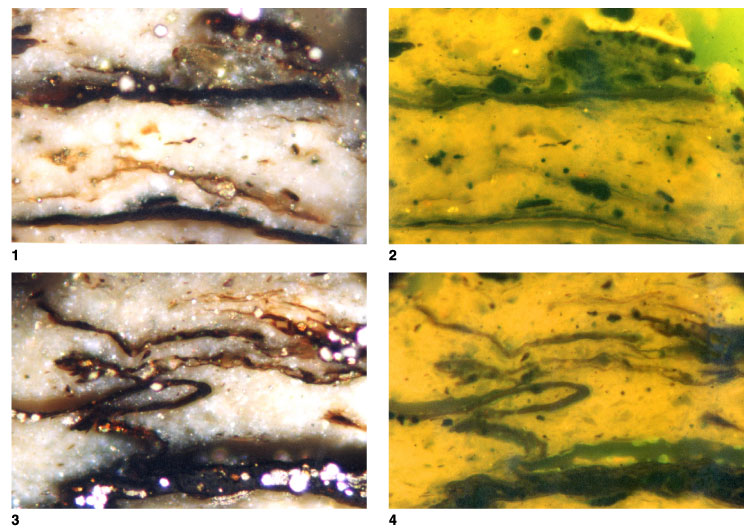
Plate P12.
Dispersed organic matter. 1.
T5842; Hole 1115C; 514.24 mbsf. Claystone with abundant plant fragments (DOM).
In this field most appear to have affinities with liptinite but a few show
strong fluorescence (reflected light; field width = 0.22 mm; vitrinite
reflectance = 0.30%). 2.
T5842; Hole 1115C; 514.24 mbsf. Same as figure 1, but in fluorescence mode.
Claystone with abundant plant fragments (DOM). In fluorescence mode the DOM can
be seen to be cutinite, but fluorescence ranges from very weak (two longer
occurrences) to moderate, short fragments (upper right) (reflected light; field
width = 0.22 mm; vitrinite reflectance = 0.30%). 3.
T5842; Hole 1115C; 514.24 mbsf. Claystone with abundant DOM. The lower lens is
vitrinite, probably telovitrinite, but the upper fragments are mainly of
cutinite. These have a very low reflectance and are partially translucent. The
organic matter is associated with pyrite (reflected light; field width = 0.22
mm; vitrinite reflectance = 0.30%). 4.
T5856; Hole 1116A; 110.93 mbsf. Same as figure 3, but in fluorescence mode. Some
structures within the vitrinite may show weak fluorescence, but the cutinite
either shows very weak fluorescence or none. It is possible that the small
amount of light from the cutinite represents show-through from underlying
mineral fluorescence, but the morphology of the phytoclasts is clearly that of
cutinite (reflected light; field width = 0.22 mm; telovitrinite reflectance =
0.42%). Click on image or number to see enlargement.



![]()